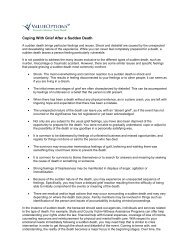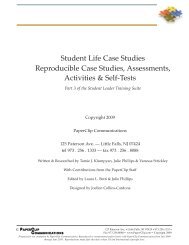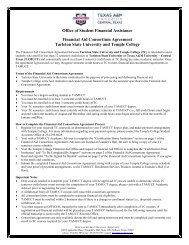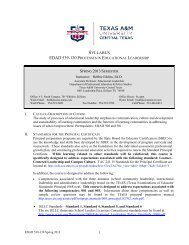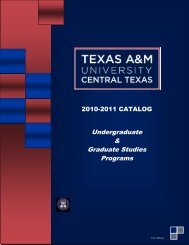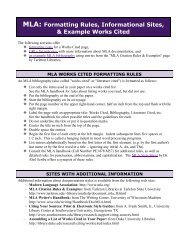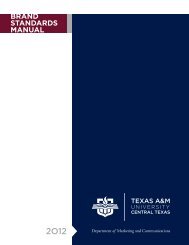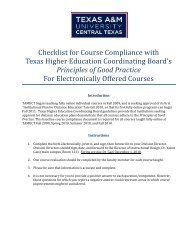Texas Budget Response - Texas A&M University-Central Texas
Texas Budget Response - Texas A&M University-Central Texas
Texas Budget Response - Texas A&M University-Central Texas
You also want an ePaper? Increase the reach of your titles
YUMPU automatically turns print PDFs into web optimized ePapers that Google loves.
ADMINISTRATOR'S STATEMENT<br />
82nd Regular Session, Agency Submission, Version 1<br />
Automated <strong>Budget</strong> and Evaluation System of <strong>Texas</strong> (ABEST)<br />
DATE:<br />
TIME:<br />
PAGE:<br />
8/9/2010<br />
9:05:02AM<br />
1 of 6<br />
Agency code: 770<br />
Agency name:<br />
<strong>Texas</strong> A&M <strong>University</strong> - <strong>Central</strong> <strong>Texas</strong><br />
History<br />
Located in Killeen and serving the <strong>Central</strong> <strong>Texas</strong> region, <strong>Texas</strong> A&M <strong>University</strong>-<strong>Central</strong> <strong>Texas</strong> (TAMUCT) became the 10th member of The <strong>Texas</strong> A&M <strong>University</strong> System<br />
(TAMUS) on May 27, 2009, when Governor Rick Perry signed Senate Bill (SB) 629. The path to stand-alone status began for TAMUCT in 1999 when the <strong>University</strong> of<br />
<strong>Central</strong> <strong>Texas</strong> (UCT), a private university, transitioned to become a System Center of Tarleton State <strong>University</strong> (TSU). TSU adopted the degree programs formerly offered by<br />
UCT so that existing students could pursue their degrees without interruption.<br />
The System Center expanded access to affordable, upper-level undergraduate and graduate education in <strong>Central</strong> <strong>Texas</strong>, educational opportunities previously offered only by<br />
private institutions in Killeen, Belton, and Waco. In 2009, enrollment increases reached 1,000 full-time student equivalents (FTE), the threshold level required for stand-alone<br />
status. In its ten years of operation under TSU's administration, the System Center awarded approximately 4,500 baccalaureate and graduate degrees. It is upon that impressive<br />
record of service to a rapidly growing region that TAMUCT has been founded with the overwhelming support of the citizens of <strong>Central</strong> <strong>Texas</strong>.<br />
Major accomplishments<br />
In the thirteen months since the Legislature approved the creation of TAMUCT, TAMUS has received the transfer of 672 acres of land from the United States Department of<br />
the Army as the site for a permanent TAMUCT campus. A master plan for the new campus has been completed and the design of the first building is 75% complete.<br />
Construction will begin on a 103,000 square foot, multi-functional classroom/office building in September 2010. Sources of funding are $25 million in Tuition Revenue Bonds<br />
(TRB's) and $15 million from the Permanent <strong>University</strong> Fund (PUF).<br />
Fall semester enrollments at TAMUCT grew from 1,878 in 2008 to 2,188 in 2009, a growth rate of 17%. The most conservative estimates of approximately 6% growth would<br />
produce a Fall 2010 enrollment of just over 2,300 students. However, preliminary projections indicate strong potential for double digit growth, and a Fall 2010 enrollment<br />
exceeding 2,500 students. Two of those indicators are enrollment growth from Spring 2009 to Spring 2010 of 18.3%, and from Summer 2009 to Summer 2010 of 29.7%.<br />
With approximately 63% of the headcount growth at TAMUCT from Fall 2008 to Fall 2009 due to non-white enrollment, the university continues to demonstrate success in<br />
meeting Closing the Gaps goals for participation. At the same time, preliminary data for this new university also shows promise for improving student completion. The 4 year<br />
graduation rate of "first-time undergraduate transfer students" from the 2005 cohort of students initially entering through the System Center was 57% for White/ Non-Hispanic<br />
students, slightly better than the statewide average of 55%. However, the rate for African American students at TAMUCT is 62%, and for Hispanics it's 70%. In fact, 65% of<br />
baccalaureate degrees awarded at TAMUCT in 2009 (mindful again that these students entered through the System Center) were to first generation students. More extensive<br />
data will be available in the coming years, but current trends show positive progress toward improved student completion.<br />
Significant Changes in Policy<br />
TAMUCT is required to follow the policies of TSU until the new university receives full accreditation from the Commission on Colleges of the Southern Association of<br />
Colleges and Schools. However, TAMUCT has the ability to develop its own policies with Tarleton’s cooperation and, when required, with the approval of The <strong>Texas</strong> Higher<br />
Education Coordinating Board (THECB).<br />
For example, transfer students had been required to have official transcripts sent to the university prior to being admitted, or they would be provisionally admitted as a freshman<br />
until their transcripts were received. However, as an upper-level institution, TAMUCT is not allowed to admit freshmen. This policy affected many students who had attended<br />
several colleges and universities (especially students on active-duty in the military) because they could not get their official transcripts to the university in time to be admitted<br />
and enrolled. TAMUCT, with permission from THECB, worked out a solution that benefits all students. Under the new policy, students are provisionally admitted to the<br />
university and can enroll in classes. They are allowed to have the length of their first semester to submit official transcripts to the university.<br />
Page 1 of 81



